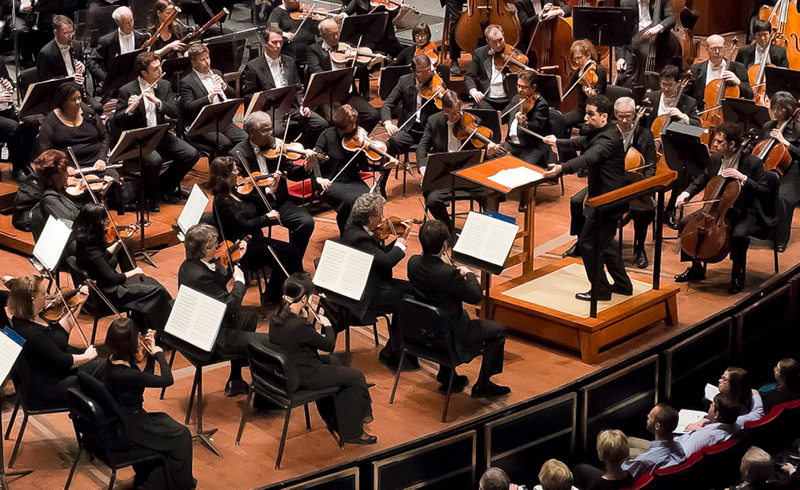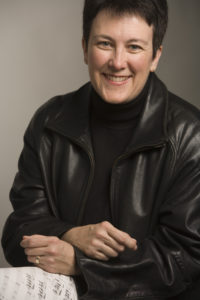
April 8, 2015
Jennifer Higdon Comes to Houston

Jennifer Higdon’s path to a Pulitzer Prize and Grammy began with a pawn-shop flute . And she didn’t even pick that up until she was 15 years old.
“It’s kind of stunning to think about the trajectory. I got a very late start,” Higdon says.
Higdon will come to Jones Hall April 17-19, when Robert Spano, the Atlanta Symphony’s music director and a longtime champion of Higdon’s music, conducts the Houston Symphony in two works that helped launch her career. The eloquent blue cathedral, composed in 2000, is a musical journey inspired by her younger brother’s death from cancer; the League of American Orchestras has said it’s the most-performed orchestral piece written in the past 25 years. Higdon’s Concerto for Orchestra, premiered by the Philadelphia Orchestra in 2002, celebrates the virtuosity of that group and of any orchestra that masters this sonic showpiece.
Q. What led you to try playing that flute?
A. It was lying around the house. My mom had gotten the flute at a pawn shop, and the most elementary band (instruction) book you could have. But I don’t remember her playing. For the life of me, I don’t know what compelled me to pick it up. I must have felt some connection to music.
I loved the feel of the instrument and the sound of the music. I didn’t really know any classical music. The big thing in my high school was marching band – we didn’t have an orchestra. Somewhere inside of me, I must have recognized the power of music and been attracted to that.
Q. And that was enough to make you major in music in college?
A. At the time, I was thinking I’d like to be a pro flute player. I thought of maybe a job in a symphony orchestra. Maybe it’s good that I was clueless as to what that entails. If I had known, I might not have started down this path!
Q. What made you go from playing music to creating it?
A. I got interested in composing about halfway through college (at Bowling Green State University). We had someone coming to do a flute master class. Usually, the teacher assigns you to play a piece, and the person doing the master class comments on that. But this time, my flute teacher said to me, “I want you to write a piece.” I should ask her why! I must have said something that suggested I was interested in it.
Q. What did you compose?
A. It was a simple little two-minute piece for flute and piano. I thought composing it was fun. I don’t know if it was arranging the sounds that I liked – I’m not really sure what it was – but I thought it was completely cool. So I kept doing it. I wrote for my friends, for flute choir, for flute duet.

Q. Meanwhile, the orchestra at your school got a new director: Robert Spano, who would go on to champion your music. Did you have any inkling that big things were in store?
A. I think he was only like 23 when he took that job. It was his first job out of school. I still remember his audition – I was in the room when he got up in front of the orchestra. It was kind of startling how good he was.
I remember that after he started at Bowling Green, both of us applied to study at Tanglewood (the Boston Symphony’s summer festival and school), him as a conductor and me as a composer. And neither of us got in!
Q. But you did get into the Curtis Institute in Philadelphia for graduate work. When did you decide to shoot for becoming a composer?
A. In the last year and a half of my undergraduate, my brain started making the switch. I loved playing the flute, but the world of the composer was a much bigger world. It was at Curtis that I finally switched over from flute to composing.
Q. Curtis later commissioned blue cathedral. Were you thinking of your brother from the outset?
A. It was about a year after I lost my brother. So I was still in that intense grieving period. The combination of the emotions and the things I was thinking about – it just kind of showed up on the paper. I did a lot of chamber pieces and choral works during that time, and you can tell that something had happened in my life. They have a certain intensity to them.
I had a feeling the piece would be important for me, but I didn’t know how. It gets played somewhere every weekend, amazingly.

Q. And your Concerto for Orchestra also has personal meanings, in a way?
A. The Philadelphia Orchestra asked specifically for something that would highlight the players (many of whom teach at Curtis, where she met them). So I thought a lot about the people. To me, music is about people – it’s about making a connection. I thought about Jeffrey Khaner, the principal flute, and how beautiful his sound is up high. That’s why the flute line goes so high. The oboe line runs the entire range of the instrument. It’s very much like Richard Woodhams, the principal oboe. He has great tone – kind of regal.
The Philadelphia Orchestra premiered it during a League of American Orchestra conference. That performance changed my life overnight, literally. People (from across the United States) had come to the conference to hear the orchestra’s new concert hall. Nobody had any idea who I was.
Amazingly, the piece went off great. I remember walking out on the stage, and the entire audience went up on its feet. It was an overwhelming experience. The phone started ringing the next day, and commissions started coming in. And they haven’t stopped since.
(Question and answers have been edited)
 Steven Brown
Steven Brown
Steven Brown is a Houston writer specializing in classical music and the arts. He has been the classical music critic of the Houston Chronicle,Charlotte Observer (N.C.) and Orlando Sentinel (Fla.).
Don’t miss Jennifer Higdon with the Houston Symphony! Hear from Jennifer herself at our Prelude pre-concert talks April 17, 18 and 19!
Ohlsson Plays Chopin
April 17, 18, 19, 2015
Robert Spano, conductor
Garrick Ohlsson, piano






